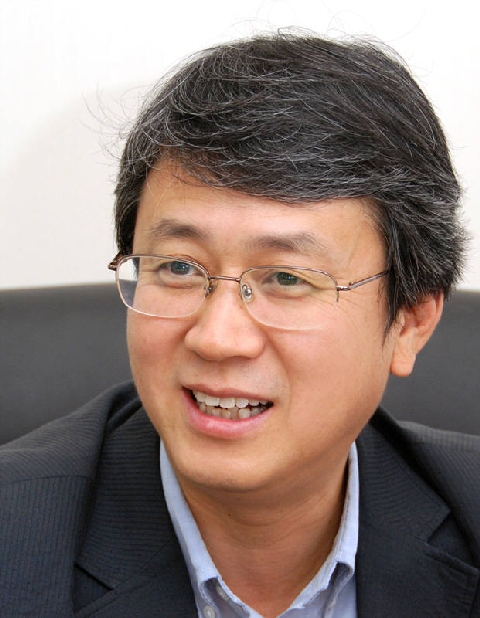A new battery with lifespan more than five times that of lithium ion battery has been developed.
It was announced on the 3rd that Professor Kim Do-gyeong`s research team from Dept. of Materials Science and Engineering at the KAIST (President: Kang Sung-mo), together with Professor Choi Chang-wook from EEWS, had successfully developed a lithium sulfur battery with lifespan and energy density five times higher than those of the commercialized lithium ion battery.
The research outcome was published on the 3rd as a frontispiece of the Advanced Materials, an international academic journal in the field of nano materials.
The lithium sulfur battery has the max. energy density per unit weight of 2100Wh/kg, which is 5.4 times higher than that of the commercialized lithium ion battery (max. 387Wh/kg). In addition, the problem of rapid capacity decrease according to the battery charge and discharge, which exists in the previously developed lithium sulfur battery, has been solved. Therefore, the new lithium sulfur battery can be charged and discharged hundreds of times.
In fact, Professor Kim’s research team fabricated an electrode material by vertically aligning sulfur nano wires measuring 75nm in thickness and 15㎛ in length using nano electrode material compounding technology and tested the material. The test results indicated that 99.2% of the initial capacity was maintained after 300 times of charging and discharging administered every three minutes. The capacity was maintained by 70% or more even after 1000 times of charging and discharging.
The sulfur nano wire alignment structure created by the research team is one-dimensional, and thus enables rapid movement of electrons. In addition, the surface of sulfur nano wire is uniformly coated with carbon to prevent direct contact with sulfur and electrolyte, and thus the melting of sulfur during battery charge and discharge is prevented. Through this process, the issue of lowered lifespan associated with existing lithium sulfur battery was solved.
The electrode for the previously developed lithium sulfur battery has large capacity in the beginning. However, the capacity continuously decreases as battery charge and discharge is repeated.
“Lithium sulfur battery is a technology that will accelerate the realization of a next-generation high-performance secondary battery necessary in unmanned air vehicles, electric vehicles and renewable energy storage devices,” explained Professor Kim Do-gyeong. “We forecast that commercial level technology development will be possible within the next five years.”
Park Hee-beom| hbpark@etnews.com
KAIST연구진, 리튬이온 수명 5배 넘는 `리튬황 전지` 개발...5년내 상용화
<리튬황배터리를 개발한 김도경 KAIST교수.>
리튬이온 전지보다 수명을 5배 이상 개선한 새로운 배터리 기술이 개발됐다.
KAIST(총장 강성모) 신소재공학과 김도경 교수 연구팀은 EEWS 최장욱 교수와 공동으로 현재 상용화 중인 리튬이온 전지의 수명 및 에너지 밀도를 5배 이상 뛰어넘는 리튬황 전지를 개발하는데 성공했다고 3일 밝혔다.
이 연구결과는 나노소재 분야 국제 학술지 `어드밴스트 머티리얼스(Advanced Materials)` 3일자 표지논문(frontispiece)으로 실렸다.
이번에 개발한 리튬황 전지는 △단위 무게당 에너지 밀도가 최대 2100Wh/㎏으로 상용화 중인 리튬이온전지(최대 387Wh/㎏)의 5.4배에 달하고 △기존에 개발된 리튬황 전지가 갖는 충?방전에 따른 급격한 용량감소 문제를 해결해 수백번 충?방전이 가능하다.
실제 김 교수 연구팀은 나노 전극 재료합성기술을 활용, 두께 75㎚, 길이 15㎛의 황 나노와이어를 수직으로 정렬해 전극 재료를 제작한 뒤 시험한 결과 3분마다 1회 충?방전 조건에서 300회의 충?방전 후에도 초기 용량의 99.2%를 유지했다. 1000회의 충?방전 후에도 70% 이상 용량을 나타냈다.
연구팀이 만든 황 나노와이어 정렬 구조는 1차원 구조체로 빠른 전자의 이동이 가능하다. 또 황 나노와이어 표면에 균일하게 탄소를 코팅해 황과 전해액의 직접적인 접촉을 막아 충?방전 중 황이 녹아나는 것을 방지하는 방법으로 리튬황 전지가 갖는 수명저하 문제를 해결했다.
기존에 개발된 리튬황 전지용 전극은 초기에 높은 용량을 보임에도 불구하고 충?방전을 반복함에 따라 지속적인 용량감소를 보이는 문제가 있었다.
김도경 교수는 “리튬황 전지는 무인기, 전기자동차 및 재생에너지 저장장치 등에 필요한 차세대 고성능 이차전지의 실현을 앞당길 수 있는 기술”이라며 “향후 5년 내 상용기술 개발이 가능할 것으로 내다보고 있다”고 말했다.
박희범기자 | hbpark@etnews.com
